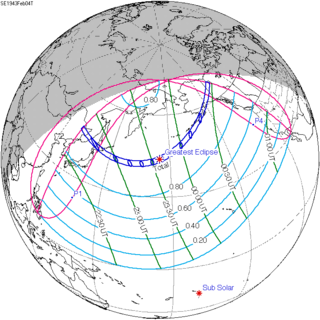| Solar eclipse of February 4, 1943 | |
|---|---|
| Type of eclipse | |
| Nature | Total |
| Gamma | 0.8734 |
| Magnitude | 1.0331 |
| Maximum eclipse | |
| Duration | 159 s (2 min 39 s) |
| Coordinates | 43°36′N 175°06′E / 43.6°N 175.1°E |
| Max. width of band | 229 km (142 mi) |
| Times (UTC) | |
| Greatest eclipse | 23:38:10 |
| References | |
| Saros | 120 (57 of 71) |
| Catalog # (SE5000) | 9382 |
A total solar eclipse occurred at the Moon's descending node of orbit between Thursday, February 4 and Friday, February 5, 1943,[1] with a magnitude of 1.0331. A solar eclipse occurs when the Moon passes between Earth and the Sun, thereby totally or partly obscuring the image of the Sun for a viewer on Earth. A total solar eclipse occurs when the Moon's apparent diameter is larger than the Sun's, blocking all direct sunlight, turning day into darkness. Totality occurs in a narrow path across Earth's surface, with the partial solar eclipse visible over a surrounding region thousands of kilometres wide. Occurring only about 22 hours after perigee (on February 4, 1943, at 1:30 UTC), the Moon's apparent diameter was larger.[2]
It began on the morning on February 5 (Friday) over northeastern China (then occupied by Manchukuo), Primorsky Krai in the Soviet Union (now Russia), Hokkaido and southern Kunashir Island in Japan (Kunashir now belonging to Russia) and ended at sunset on February 4 (Thursday) over Alaska and Yukon in Canada. A partial eclipse was visible for parts of East Asia, Hawaii, and western North America.
- ^ "February 4–5, 1943 Total Solar Eclipse". timeanddate. Retrieved 4 August 2024.
- ^ "Moon Distances for London, United Kingdom, England". timeanddate. Retrieved 4 August 2024.
